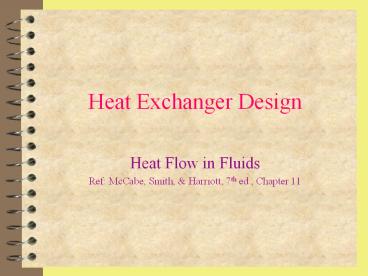Heat Exchanger Design - PowerPoint PPT Presentation
1 / 16
Title:
Heat Exchanger Design
Description:
8/28/2006. ChE4151 HE01. 3. Heat. Energy in transient driven ... Do = tube outside diameter. Di = tube inside diameter. DLM = log mean of Di and Do. 8/28/2006 ... – PowerPoint PPT presentation
Number of Views:1098
Avg rating:3.0/5.0
Title: Heat Exchanger Design
1
Heat Exchanger Design
- Heat Flow in Fluids
- Ref McCabe, Smith, Harriott, 7th ed., Chapter
11
2
Learning Objectives
- What is heat?
- How do we determine the heat duty of an
exchanger? - What are the modes of heat transfer?
- How do we find the mean temperature difference?
- What is the heat transfer coefficient?
- How to estimate the required heat transfer area?
- How does phase change affect the design of an
exchanger?
3
Heat
- Energy in transient driven by a temperature
difference - Flows from the hot fluid to the cold fluid
- The enthalpy of the cold fluid increases
- The enthalpy of the hot fluid decreases
4
Heat Exchanger
5
Enthalpy Balances
q UA?TM
Heat duty
mc mass rate of cold fluid mh mass rate of
hot fluid H specific enthalpy a denotes
inlet conditions b denotes outlet conditions
6
Heat Duty
q UA?TM
- Sensible heat
- Latent heat (phase change)
- Both sensible and latent heat
cp specific heat at constant pressure ?
latent heat of vaporization (condensation)
7
Temperature Difference
q UA?TM
?T1 Tha Tca
?T2 Thb Tcb
Temperature Changes (Tha Thb) ? ?T
(Tcb Tca) ? ?T
8
Mean Temperature Difference
q UA?TM
- When the heating and cooling curves are straight
lines, that is, when T vs q lines are straight
for both the hot and the cold fluids
9
Log Mean Temperature Difference
- It is the mean of two numbers
- As the numbers approach each other it approaches
the arithmetic mean
Notice that the LMTD is less than the arithmetic
mean (AMTD).
10
Over-all Heat Transfer Coefficient
q UoAo?TM
ho outside film coefficient hi inside film
coefficient x tube wall thickness km tube
metal conductivity rf fouling resistance Do
tube outside diameter Di tube inside
diameter DLM log mean of Di and Do
11
Heat Transfer Area
Q UoAo?TM
Nt total number of tubes
12
Parallel Flow
Both fluids enter at the same end of the
exchanger and exit at the other end.
13
Countercurrent Flow
Fluids enter at opposite ends of the exchanger.
Countercurrent is more efficient than parallel
for transferring heat!
14
Condensing Pure Vapor (e.g., steam)
The condensing temperature does not change! The
log mean temperature difference applies.
15
Cooling and Condensing Vapors
The ?TLM does not apply to the end points!!! The
exchanger must be divided into two sections for
sizing.
16
Summary
- Heat exchanger design equation
- Heat duty q is obtained from an enthalpy balance
- Mean temperature difference ?TM depends on the
temperature profiles--heating/cooling curves - Log mean temperature difference applies only when
the heating/cooling curves are straight - The design of the heat exchanger involves the
determination of the required heat transfer area
A - This requires the estimation of the heat transfer
coefficient U































